
|
|
 |

|


|
Sharp AQUOS LC-40LE700UN Review
40" 1080p LCD HDTV, $1499
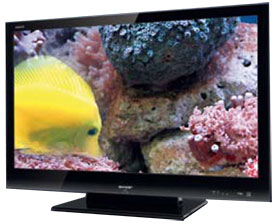
Dick De Jong Introduction
Lightness. The Sharp AQUOS LC-40LE700UN embodies this characteristic in three remarkable ways. First, this 40" HDTV weighs less than 27 pounds (without its stand). A couple of years ago, 40" TVs often were two to three times heavier. Second, this LED backlit model is light on the environment. Not only does it consume a paltry 75W of electricity, but also LEDs are a mercury-free light source. Finally, this 1080p, 120Hz AQUOS's Full Array LED backlight produces a light, bright picture. And even though the system does not employ local dimming, the blacks are surprisingly deep and satisfying. (Editor's Note: Sharp also manufactures three other sizes of the LE700 series, the 52" LC-52LE700UN, the 46" LC-46LE700UN and the 32" LC-32LE700UN. The 46" and 52" models include a special dejudder feature for film content. And the 32" TV does not offer AQUOS Net nor a USB port. Other than that, all the TVs have similar specifications and this review of the LC-40LE700UN can apply.) Our Star Ratings
Performance: 4.0 The picture quality is very good from this LED backlit LC-40LE700UN. I especially liked its wider than usual viewing angle. The audio output from the integrated 10W speakers is fine for everyday use.
Features: 4.5 This Sharp supplies most of the bells and whistles that you expect from a late 2009 model. Its lineup of Internet partners does not include streaming content from the likes of YouTube or Netflix, but does offer some other content, like photo galleries, not always available on other TVs.
Ease of Use: 4.5 A hidden factor when considering ease of use is the weight of the TV. This 40" AQUOS is the lightest one that I have had the pleasure to move around. I wouldn't consider any 40" TV portable, but at 31 pounds, you could easily tote it from room to room.
Value: 4.0 Sharp lists the LC-40E700UN at $1499, but I just surfed the Internet and found it at a number of retailers for around $1150, and in some cases, a lot less. These days, 40" TVs are a sweet spot in the market and you can find real deals on traditional CCFL backlit LCDs.
But this Sharp does offer state-of-the-art LED technology which not only translates into higher performance but also one of the most power conscious TVs available.
Star Ratings Description Ratings are relative to when the review was written. The obvious example is Value, what you could purchase for $2000 two years ago or even two months ago would seem like a bad value for that price now. We have given only a precious few 5 Star ratings, which we reserve for truly outstanding accomplishment.
Out of the Box
After lugging around some mighty massive TVs lately, we were faked out by this 40" feather. We had braced our backs for a power lift and after the first tug, we realized that pulling this AQUOS out of the box was easy breezy.  At 26.5 pounds (without the stand), I've hung framed artwork that is heavier than this LC-40LE700UN. HDTVs are not at the paper thin, light-as-air stage yet, but I can see it on the horizon. Even the 52" model of this LE700 series tips the scale at only 51 pounds. 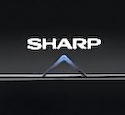
The one and a half inch piano black bezel is standard issue. The only distinguishing mark is the inverted V (under the Sharp logo) that glows blue when the AQUOS is on. All the controls and connections are on the right side of the TV. On the edge closest to the front are the operational buttons. Stepped back a bit but still facing the side is the convenience panel that contains one HDMI input, one Composite Video In with stereo Audio Ins, and a USB port for uploading JPEG photos and MP3 songs. 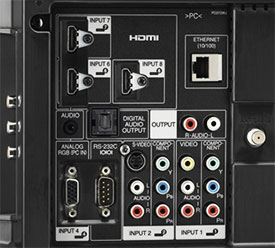
Next to this panel on the back, a larger panel includes three more HDMI inputs, two Component video (YPbPr) Ins (with matching stereo Audio Ins), one more Composite Video In, one VGA PC input with an Audio In (stereo minijack), and an RS-232C port for custom installations. For sending audio to external speakers or a receiver, an SPDIF (optical) digital Audio Out is provided next to analog L/R Stereo Outs (with fixed volume). The one RF antenna connector links to integrated NTSC/ATSC/QAM tuners. Since the tuner system is Clear QAM compatible, you can attach your cable TV signal directly into the RF connector and tune in unscrambled cable stations. The ATSC tuner is the one that you need to capture digital signals broadcast over-the-air. The Ethernet port allows you to connect the LC-40E700UN directly to the Internet. Sharp provides its own unique interface called AQUOS Net, which does not have the usual streaming content partners like YouTube and Netflix. Sharp's partners include NBC with headlines and stories from NBC Sports and MSNBC. AQUOS Net also features a comics widget, a games (Sudoku and Blackjack) category, local traffic updates and two image galleries. 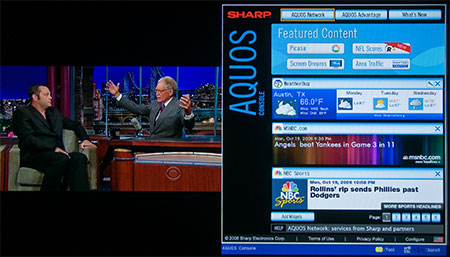 If you are a multi-tasker, you can split the screen and watch Dave while you are checking up on sports scores. I would prefer to have at least one streaming movie source like Blockbuster or Amazon or Netflix. And almost all these Internet interfaces on a TV are somewhat unwieldy simply because they lack the mobility of a mouse. But the movement to meld the Internet and your HDTV marches inexorably onward. 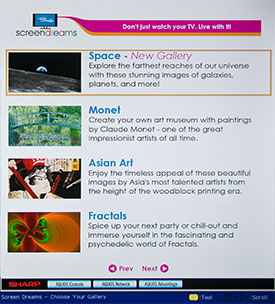
The collection of images supplied in the AQUOS Network would make a good backdrop during parties. Of course, if you fancy yourself as a budding photographer, you can upload your favorite JPEGs on a USB Flash drive. The Sharp photo menu limits you to three slideshow playback speeds, 10, 30 or 60 seconds. No transition options are available. Slides simply cut from one to the next. You can pick from various picture modes, but most of the controls in the Picture menu are not available. You can also listen to MP3 songs on the USB drive either separately or as accompaniment to the slideshow. The TV does not include Picture-in-Picture functionality. 
The black wedge of a remote control is partially backlit. I'm not so sure what is special about the Power Saving, Freeze, Menu and Mute buttons, but when you push the Light button, they are the only ones, along with the Volume rocker, that illuminate. Some of the stenciled titles are difficult to read and I wish the A/V Mode button was not sequestered behind the flip down door at the bottom end of the remote. Before we move on, let me discuss again this new technology called LED backlighting. The LC-40E700UN is an LCD TV and like all LCDs, the panel is backlit. Traditionally, CCFLs (cold cathode fluorescent lights) have been used as the backlight source. In the last year, manufacturers have begun replacing CCFLs with LEDs (light emitting diodes), though the great majority of new LCD TVs still use CCFLs. Designers of LED TVs are placing these little light sources in one of two different locations. Right now, the more common method is to position the LEDs around the outer edge of the LCD, often called side light or edge-lit. The second method, (often termed direct), and the one that Sharp employs with the LC-40E700UN is to place an array of LEDs behind the LCD panel. Sharp describes their system as "a full array of LEDs evenly dispersed behind the diffuser, resulting in more uniform colors and brightness across the entire screen." One of the advantages of a direct LED backlight is that it allows for a technique called local dimming, which I really like. To be clear, not all direct LED backlit TVs enable local dimming. And this AQUOS does not use local dimming. With that said, the display still produces highly respectable blacks. Power Consumption
The EPA is now publishing a list of ENERGY STAR qualified TVs. (You can find it here.) The Sharp AQUOS LC-40E700UN is on the list. 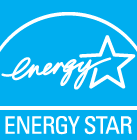
The EPA states that this Sharp's On Mode Power is 75W and Standby Power Consumption is .5W. Based on the formula that the TV is on five hours a day and in Standby for the other 19, the Estimated Annual Energy Use is 140 kWh/year. You need to check your electric bill to see how much you are paying for a kWh. The rate that I have been using in previous reviews is 10.4 cents. Doing the multiplication, at that rate, the yearly energy cost is $14.56. Since manufacturers are not attaching those yellow ENERGY STAR tags that you find on air conditioners and refrigerators, you will have to study the ENERGY STAR list to see how the LC-40E700UN compares to other 40" TVs. Though, Sharp states that "this series offers the industry's lowest power consumption of any LCD TV currently available on the market." At 75W, I can believe that claim. Of course, I also assume that other manufacturers are gunning for the lowest power consumption title and the competition only bodes well for Mother Earth. Setup
To calibrate the TV, we use two discs, the Blu-ray version of the Digital Video Essentials DVD called HD Basics and the Spears & Munsil High Definition Benchmark Blu-ray DVD. We are playing the DVDs on the OPPO BDP-83 Blu-ray player connected to the HDTV with an HDMI cable. We use the test patterns to adjust black level, white level, and color bias. The player is set to output a 1080p signal, which is the native resolution of the LC-40E700UN. Before I begin, Sharp offers a fascinating service that I didn't try. Basically, AQUOS advisors can connect remotely to your TV through AQUOS Net and assist in tweaking the picture settings. If you just don't want to get your hands dirty under the hood or you simply need a little hand holding, you may wish to consider this interactive tool, known as AQUOS Advantage Live. If you are a DIYer, then read on. I usually start by picking a picture mode. The choices are commonly found in the Picture Menu. On this AQUOS, picture modes are called AV Modes and the button to change them is found under the flip down door on the remote. 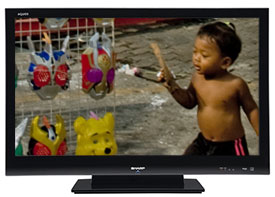
Sharp provides eight options: Standard, Movie, Game, PC, User, Auto, Dynamic (Fixed) and Dynamic. I always suggest to cycle through them as you are watching a typical program and see if one pleases your eye. If so, good for you. You can go out and play. If you are still with me, I picked User and then entered the Picture Menu and looked for the Color Temperature control, which I found in the Advanced Picture Setting sub-menu. From the five choices, Low (warm), Mid-Low, Middle, Mid-High and High (cool), I opted for Mid-Low. Color Temp is a personal decision. If you are really discerning, you can fine tune white balance with individual Gain controls for Red, Blue and Green. Before I head back to the basic settings, I like to try to begin with as clean as slate as possible, therefore I turn off features like Active Contrast and Gamma Adjustment. I'll revisit them after I have finished my initial setup. Returning to the first page of the Picture Menu, the first choice that you have to make is called OPC, (Optical Picture Control). When turned On, OPC senses the light in your room and automatically adjusts the brightness of the TV's backlight. If the ambient light in your room changes radically while you watch TV, then you might want to turn On OPC. Our testing facility is light controlled, therefore I switched OPC Off, which allowed me to adjust the Backlight setting. I left Backlight at its mid setting of 0. According to the test patterns, I also left Brightness at 0. Contrast was a bit trickier. Some patterns seemed to indicate that Contrast should be lowered to 15, out of a scale from 0 to 40. But with real content, the picture didn't look great. I decided to ignore those test patterns and push Contrast back up towards its default. I finally felt comfortable with Contrast (Picture) at 25. The Color (Saturation) and Tint (Hue) sliders ran from -30 to +30. I settled on Color at -3 and Tint at +2. The Sharpness scale ranged from -10 to +10. Anything above 0 exhibited fringing. I left Sharpness at 0. The Color Bar test pattern looked like it could use a little extra tweaking and I delved into the C.M.S. (Color Management System) in the Advanced Picture Setting sub-menu. The C.M.S. allows you to adjust Hue, Saturation and Value individually for Red, Green, Blue, Cyan, Magenta and Yellow. I did some minor fiddling with R, C, M and Y. 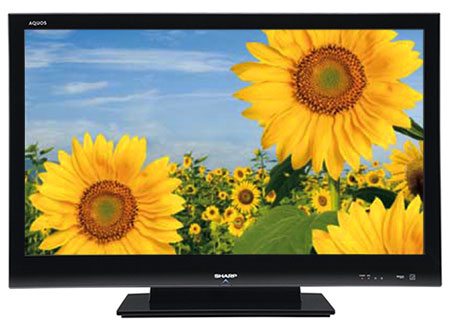 I also experimented with other Advanced settings. Fine Motion Enhanced deals with the 120Hz feature on the LC-40LE700UN. Basically, this TV displays 120 frames per second. Normally, video content is 60Hz or 60 frames per second. To achieve 120 frames, the video processor in this AQUOS either duplicates each of the original frames or interpolates a new frame in between the originals. Interpolation theoretically smooths fast action scenes and makes them less blurry, hence Fine Motion Enhanced. When Off, the display just duplicates frames. When On, new frames are interpolated to reach 120Hz. Sharp provides a separate setting for 24p movie content, called Film Mode, but it is not active for 480p, 720p or 1080p signals. As for the other two main Advanced Settings, I left Active Contrast at Off and set Gamma Adjustment to -1. Once again, test them out in your environment and see what you prefer. Performance
Once I adjusted Contrast appropriately, I was very pleased with the picture quality of the LC-40E700UN. LCD TVs with LED backlights, like this AQUOS, are fairly new on the scene, but they are already earning my respect. One of the shortcomings of traditional CCFL backlit LCDs is that their viewing angle is fairly narrow. If you sit too far left or right or up or down from the center of the screen, the image has a tendency to wash out. This Sharp, with its full array of LED backlights, produces a much wider viewing angle, which is essential if you have a big group of friends over to watch the World Series. 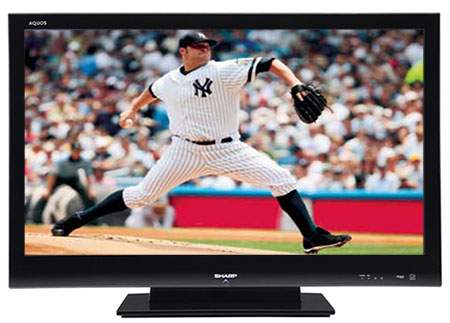 Also, the display is plenty bright, which in this case does not come at the cost of deep blacks. Now, if we are talking about truly deep, deep blacks, plasma TVs are still the kings followed closely by LED backlit LCDs with local dimming. But the LC-40E700UN, which does not feature local dimming, does just fine in the black arena. The audio performance from the integrated pair of 10W speakers is about what I foresaw, which is adequate for everyday TV viewing. I appreciate that this is a 40" TV and it should not be expected to provide room filling, home theater sound, but I was surprised that the volume was not very robust. Even cranked to the max, you will not disturb a light sleeper in the next room. Conclusion
The Sharp AQUOS LC-40E700UN heralds a new era of LED backlit LCDs that produce a big bright image while being lightweight and eco-friendly. 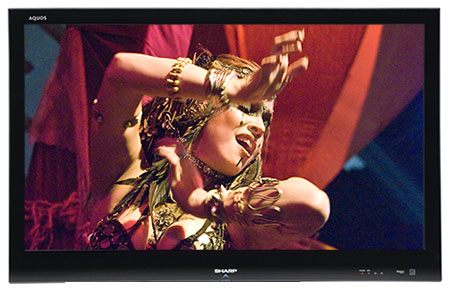 |
Bookmark:
![]() del.icio.us
del.icio.us
![]() Reddit
Reddit
![]() Google
Google
| Send this Page | Print this Page | Report Errors |


Posted May 16, 2010 1:08:46 PM
By Mark